Honda Civic Hatchback 2022 Refilling Window Washer Fluid User Manual
The Honda Civic Hatchback 2022 is a practical and stylish vehicle that requires regular maintenance to ensure optimal performance. Refilling fluids, including oil, coolant, brake fluid, and windshield washer fluid, is an essential part of this maintenance. To assist owners with this process, we will provide an overview of the refilling process for various fluids in the Honda Civic Hatchback 2022. It is important to reference the owner’s manual for specific instructions and recommendations for the Honda Civic Hatchback 2022 when it comes to refilling fluids. The manual will provide information about the type and amount of fluid needed for each component, as well as the location of the various fluid reservoirs in the vehicle. One of the most commonly refilled fluids in any vehicle is motor oil. The Honda Civic Hatchback 2022 requires synthetic oil, and the owner’s manual will provide information about the recommended oil viscosity and oil change interval. The oil level can be checked using the dipstick under the hood, and oil can be added through the oil filler cap. Coolant is another vital fluid to keep topped off. The coolant reservoir can usually be found under the hood and should be filled with a 50/50 mixture of coolant and water. It is essential to use the recommended coolant type for the Honda Civic Hatchback 2022. Brake fluid is crucial to ensure the proper function of the vehicle’s brakes. The brake fluid reservoir is typically located near the engine and should be filled with the recommended brake fluid type. The windshield washer fluid helps to keep the windshield clean and clear while driving. The reservoir for this fluid is typically located under the hood and should be filled with the recommended windshield washer fluid. By following these recommendations, owners can keep their Honda Civic Hatchback 2022 in top condition.
Refilling Window Washer Fluid
Check the amount of window washer fluid. If the level is low, fill the washer reservoir.
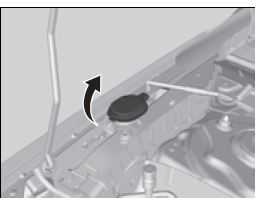
Canadian models
If the washer fluid is low, a message appears on the driver information interface. Pour the washer fluid carefully. Do not overflow the reservoir.
NOTICE
Do not use engine antifreeze or vinegar/water solution in the windshield washer reservoir. Antifreeze can damage your vehicle’s paint. A vinegar/water solution can damage the windshield washer pump. Use only commercially available windshield washer fluid. Avoid prolonged use of hard water to prevent lime scale buildup.
Replacing Light Bulbs
Headlights
Headlights are LED type. Have an authorized Honda dealer inspect and replace the light assembly.
Fog Lights
Fog lights are LED type. Have an authorized Honda dealer inspect and replace the light assembly.
Front Turn Signal Lights
Front turn signal lights are LED type. Have an authorized Honda dealer inspect and replace the light assembly.
Front Side Marker Lights
Front side marker lights are LED type. Have an authorized Honda dealer inspect and replace the light assembly.
Parking/Daytime Running Lights
Parking/daytime running lights are LED type. Have an authorized Honda dealer inspect and replace the light assembly.
Side Turn Signal/Emergency Indicator Lights
Door mirror side turn lights are LED type. Have an authorized Honda dealer inspect and replace the light assembly.
Brake Light, Taillight, Rear Side Marker Light, and Rear Turn Signal Light Bulbs
When replacing, use the following bulbs.
Brake Light: LED
Taillight: LED
Rear Side Marker Light: LED
Rear Turn Signal Light: 21 W (Amber)
- Pry on the edge of the cover using a flat-tip screwdriver to remove the cover.
Wrap the flat-tip screwdriver with a cloth to prevent scratches.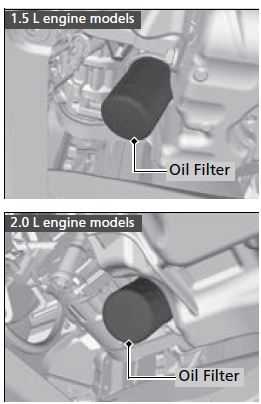
- Remove the bolts.
- Pull the light assembly out of the rear pillar.
- Turn the socket counter-clockwise and remove it.
- Remove the old bulb and insert a new bulb.
- Align the pins with the body grommets, then push in until they fully seat.
Brake lights, taillights, and rear side marker lights are LED type. Have an authorized Honda dealer inspect and replace the light assembly.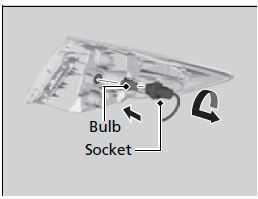
Taillight and Back-Up Light Bulbs
When replacing, use the following bulbs.
Taillight: LED Back-Up Light: 16 W.
- Remove the cover by prying on the edge using a flat-tip screwdriver. Wrap the flat-tip screwdriver with a cloth to prevent scratches.
- Turn the socket counter-clockwise and remove it.
- Remove the old bulb and insert a new bulb.

Taillights are LED type. Have an authorized Honda dealer inspect and replace the light assembly.
Rear License Plate Light
Rear license plate light is LED type. Have an authorized Honda dealer inspect and replace the light assembly.
High-Mount Brake Light
The high-mount brake light is LED type. Have an authorized Honda dealer inspect and replace the light assembly.
Checking and Maintaining Wiper Blades
Checking Wiper Blades
If the wiper blade rubber has deteriorated, it will leave streaks, become noisy, and the hard surfaces of the blade may scratch the window glass.
Changing the Front Wiper Blade
- Set the power mode to ON, then to VEHICLE OFF.
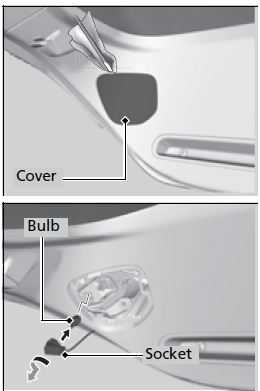
- Within 10 seconds of setting the power mode to VEHICLE OFF, hold the wiper switch in the MIST position for more than two seconds.
Both wiper arms are set to the maintenance position as shown in the image. - Lift both wiper arms.
- Depress the lock tab, then slide the wiper blade off the wiper arm.

- Slide the new wiper blade onto the wiper arm until it clicks into place.
- Lower both wiper arms.
- Set the power mode to ON, then set the wiper switch to the MIST position once. The wiper arms return to the standard position.
Avoid dropping the wiper arm onto the windshield, it may damage the wiper arm and/or the windshield.
Changing the Rear Wiper Blade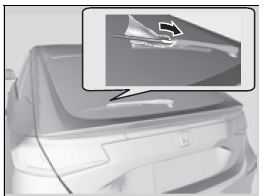
- Hold up the wiper arm.
- Insert a flat-tip screwdriver into the groove of the wiper arm to remove the wiper blade.
Wrap the flat-tip screwdriver with a cloth to prevent scratches. - Insert a new wiper blade and put the wiper arm back.
Checking and Maintaining Tires
Checking Tires
To safely operate your vehicle, your tires must be of the proper type and size, in good condition with adequate tread, and properly inflated.
Inflation guidelines
Properly inflated tires provide the best combination of handling, tread life, and comfort. Refer to the driver’s doorjamb label or specifications page for the specified pressure. Underinflated tires wear unevenly, adversely affect handling and fuel economy, and are more likely to fail from overheating. Overinflated tires make your vehicle ride harshly, are more prone to road hazards, and wear unevenly. Every day before you drive, look at each of the tires. If one looks lower than the others, check the pressure with a tire gauge. At least once a month or before long trips, use a gauge to measure the pressure in all tires, including the spare. Even tires in good condition can lose 1-2 psi (10-20 kPa, 0.1-0.2 k g f/cm2) per month.
Inspection guidelines
Every time you check inflation, also examine the tires and valve stems.
Look for:
- Bumps or bulges on the side or in the tread. Replace the tire if you find any cuts, splits, or cracks in the side of the tire. Replace it if you see fabric or cord.
- Remove any foreign objects and inspect for air leaks.
- Uneven tread wear. Have a dealer check the wheel alignment.
- Excessive tread wear.
- Wear Indicators P. 673.
- Cracks or other damage around the valve stem.
WARNING
Using tires that are excessively worn or improperly inflated can cause a crash in which you can be seriously hurt or killed. Follow all instructions in this owner’s manual regarding tire inflation and maintenance. Measure the air pressure when the tires are cold. This means the vehicle has been parked for at least three hours or driven less than 1 mile (1.6 km). If necessary, add or release air until the specified pressure is reached. If checked when hot, tire pressure can be as much as 4–6 psi (30–40 kPa, 0.3–0.4 k g f/cm2) higher than if checked when cold.
U.S. models
Whenever tire pressure is adjusted, you must calibrate the TPMS.
TPMS Calibration P. 485
Have a dealer check the tires if you feel a consistent vibration while driving. New tires and any that have been removed and reinstalled should be properly balanced.
Q&A
- What are the different fluids that need to be refilled in the Honda Civic Hatchback 2022?
- The different fluids that need to be refilled in the Honda Civic Hatchback 2022 include oil, coolant, brake fluid, and windshield washer fluid.
- What type of oil does the Honda Civic Hatchback 2022 require?
- The Honda Civic Hatchback 2022 requires synthetic oil, and the owner’s manual provides information about the recommended oil viscosity and oil change interval.
- How can you check the oil level in the Honda Civic Hatchback 2022?
- The oil level can be checked using the dipstick under the hood.
- Where is the oil filler cap located in the Honda Civic Hatchback 2022?
- The oil filler cap is located under the hood.
- What is the recommended coolant mixture for the Honda Civic Hatchback 2022?
- The coolant reservoir should be filled with a 50/50 mixture of coolant and water, and it is important to use the recommended coolant type for the Honda Civic Hatchback 2022.
- How can you check the coolant level in the Honda Civic Hatchback 2022?
- The coolant level can be checked by looking at the coolant reservoir under the hood.
- What is the role of brake fluid in the Honda Civic Hatchback 2022?
- Brake fluid helps transfer pressure from the brake pedal to the brakes themselves.
- Where is the brake fluid reservoir located in the Honda Civic Hatchback 2022?
- The brake fluid reservoir is typically located near the engine.
- What is the recommended brake fluid type for the Honda Civic Hatchback 2022?
- The owner’s manual will provide information about the recommended brake fluid type.
- What is the purpose of windshield washer fluid in the Honda Civic Hatchback 2022?
- The windshield washer fluid helps keep the windshield clean and clear while driving.
- Where is the reservoir for windshield washer fluid located in the Honda Civic Hatchback 2022?
- The reservoir for windshield washer fluid is usually located under the hood.
- Can you mix different types of brake fluid in the Honda Civic Hatchback 2022?
- No, you should never mix different types of brake fluid in the Honda Civic Hatchback 2022.
- How often should you check the fluid levels in the Honda Civic Hatchback 2022?
- You should check the fluid levels in the Honda Civic Hatchback 2022 regularly and follow the recommended maintenance schedule in the owner’s manual.
- What should you do if you notice a fluid leak in the Honda Civic Hatchback 2022?
- If you notice a fluid leak in the Honda Civic Hatchback 2022, you should have it inspected and repaired by a certified technician as soon as possible.
- Can you refill the fluids in the Honda Civic Hatchback 2022 yourself?
- Yes, you can refill the fluids in the Honda Civic Hatchback 2022 yourself, but it is important to follow the instructions in the owner’s manual and use the recommended fluids. If you are unsure about how to refill a particular fluid, it is best to have it done by a certified technician.
Useful Links
View Full User Guide: Honda Civic Hatchback 2022 User Manual
Download Manuals: https://owners.honda.com/vehicle-information/manuals


